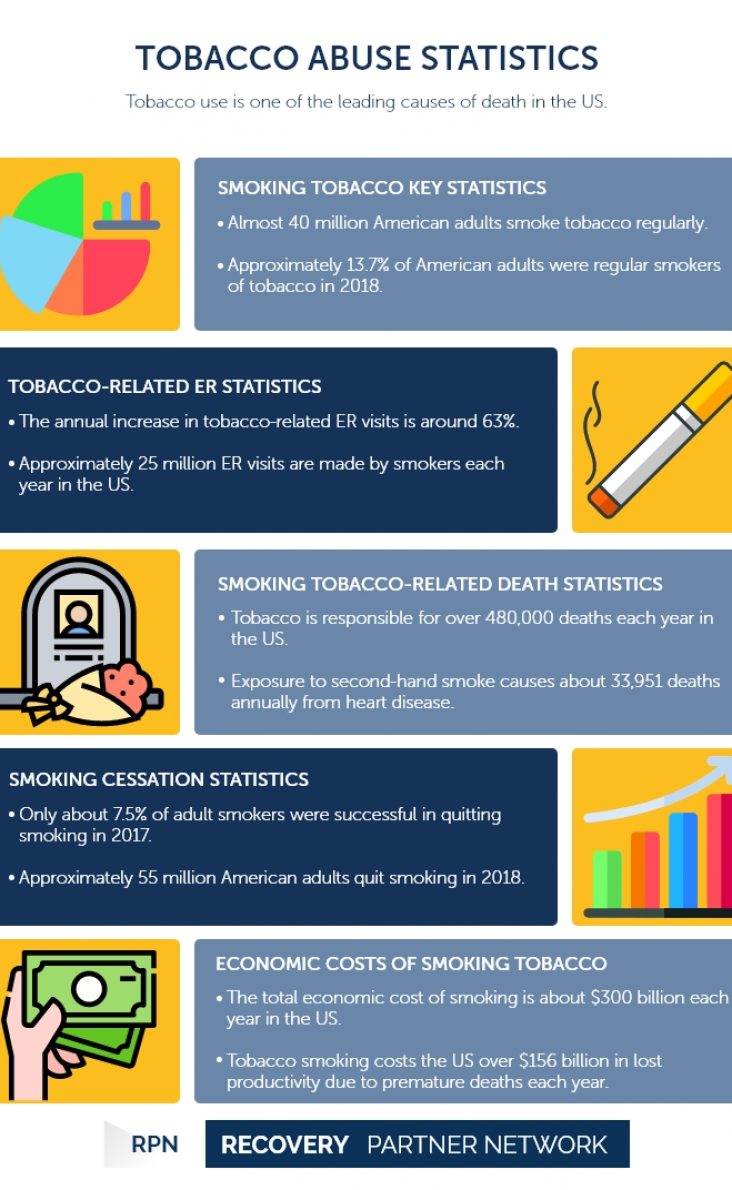Tobacco use is one of the leading causes of death in the US.
Tobacco Abuse Statistics
Substance use disorder
- Alcohol abuse statistics
- Amphetamine abuse statistics
- Cannabis abuse statistics
- Cocaine abuse statistics
- Heroin abuse statistics
- Illicit drug abuse statistics
- Inhalant abuse statistics
- Methamphetamine abuse statistics
- Opioid abuse statistics
- Prescription Drug abuse statistics
- Tobacco abuse statistics
Tobacco abuse statistics | Table of Contents
Smoking Tobacco
Tobacco is one of the most addictive and widely abused substances in the world. Most often smoked, tobacco generates a rush of adrenaline and dopamine when absorbed into the bloodstream or inhaled through a cigarette. Contrary to what is now known, tobacco was once marketed as a healthy product with beneficial effects during the 1990s, which exposed a great deal of Americans to its harmful and irreversible consequences.
Tobacco use is one of the leading causes of preventable disease, disability, and death in the United States. Despite the initiatives of various federal governments and organizations, tobacco use continues to spread across many communities and affect the lives of millions of people worldwide.
Tobacco Abuse Key Statistics
- Almost 40 million American adults smoke tobacco regularly.
- Each day, around 1600 individuals younger than 18 years smoke their first cigarette.
- Around 16 million Americans live with a serious illness or disease caused by regular smoking.
- According to the Centers for Disease Control and Prevention (CDC), approximately 13.7 percent of American adults were regular smokers of tobacco in 2018.
- Nearly 15.6 percent of men and 12 percent of women admitted to smoking tobacco regularly in 2019.
- In 2018, about 55.1 percent of adult smokers reportedly tried to quit the habit in the previous year.
- The number of tobacco smokers has significantly reduced from 20.9 percent in 2005 to 14 percent in 2019.
- Tobacco smoking was more prevalent among the 25 to 64-year-olds (33.7 percent) and least among the 18 to 24-year-olds (8 percent) in 2019 due to the aggressive campaigning against smoking.
- Tobacco smoking was more prevalent among non-Hispanic American Indians/Alaska natives (20.9 percent) and non-Hispanic other races (19.7 percent) and least among non-Hispanic Asians (7.2 percent) in 2019.
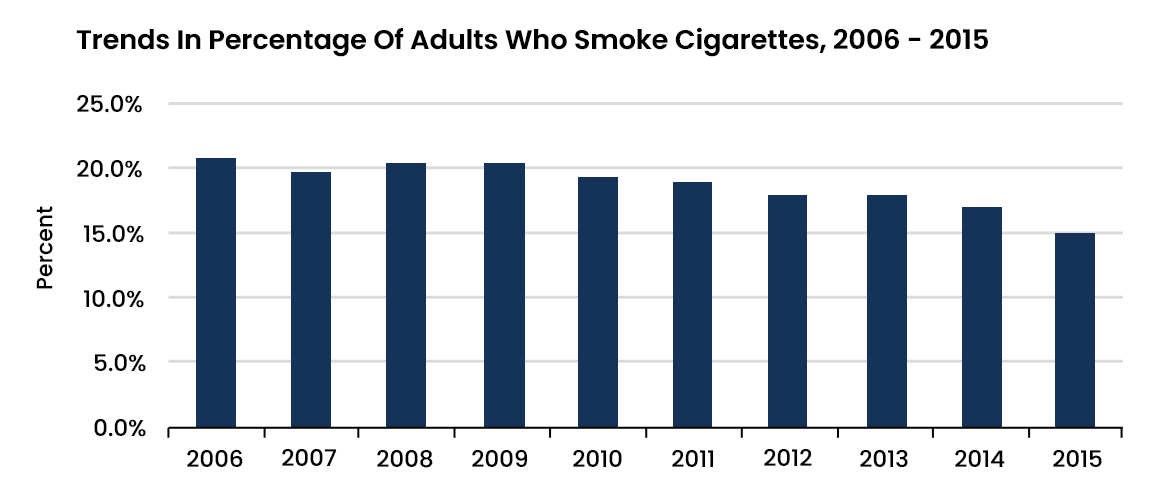
Tobacco-Related ER Statistics
Regular smokers generally experience health complications that require a visit to the emergency room due to the ailments that arise from tobacco-related diseases such as chronic obstructive pulmonary disease (COPD), coronary artery disease, lung cancer, and stroke. However, these diseases do not just affect the smoker but also those around them due to secondhand smoke.
- While smokers account for less than 14 percent of the US population, up to 30 to 40 percent of patients seen in emergency rooms are smokers.
- The annual increase in tobacco-related emergency room visits is around 63 percent.
- Most of the pediatric emergency room visits due to asthma and ear infections are related to children residing in households with smokers.
- Approximately 25 million emergency room visits are made by smokers each year in the US.
- Around 12 percent of emergency room gross billings are attributable to illnesses related to tobacco use.
- Of the 61,336 emergency room visits made to New Orleans hospitals between 2013 to 2016, about 55,777 (90.0 percent) reported current use of tobacco.
- Women represented nearly 61 percent of emergency room visits made to New Orleans hospitals between 2013 to 2016.
Smoking Tobacco-Related Death Statistics
The regular use of tobacco can lead to serious complications such as cancers, heart diseases, strokes, diabetes, and lung diseases and increase the likelihood of premature deaths. Tobacco use kills more Americans than AIDS, car crashes, illegal drugs, murders, and suicides combined.
- According to the Centers for Disease Control and Prevention (CDC), tobacco is responsible for over 480,000 deaths each year in the US.
- About 1300 Americans die each day due to smoking.
- Approximately 278,544 men and 201,773 women die each year due to smoking or exposure to secondhand smoke.
- Exposure to secondhand smoke causes about 7,333 and 33,951 deaths annually from lung cancer and heart disease, respectively.
- On average, tobacco smokers die ten years earlier than non-smokers.
- Deaths related to tobacco smoking were the highest among 70-year-olds and above and lowest among 15 to 49-year-olds between 1990 and 2017. However, the overall death rate from smoking has considerably reduced from 1990 to 2017.
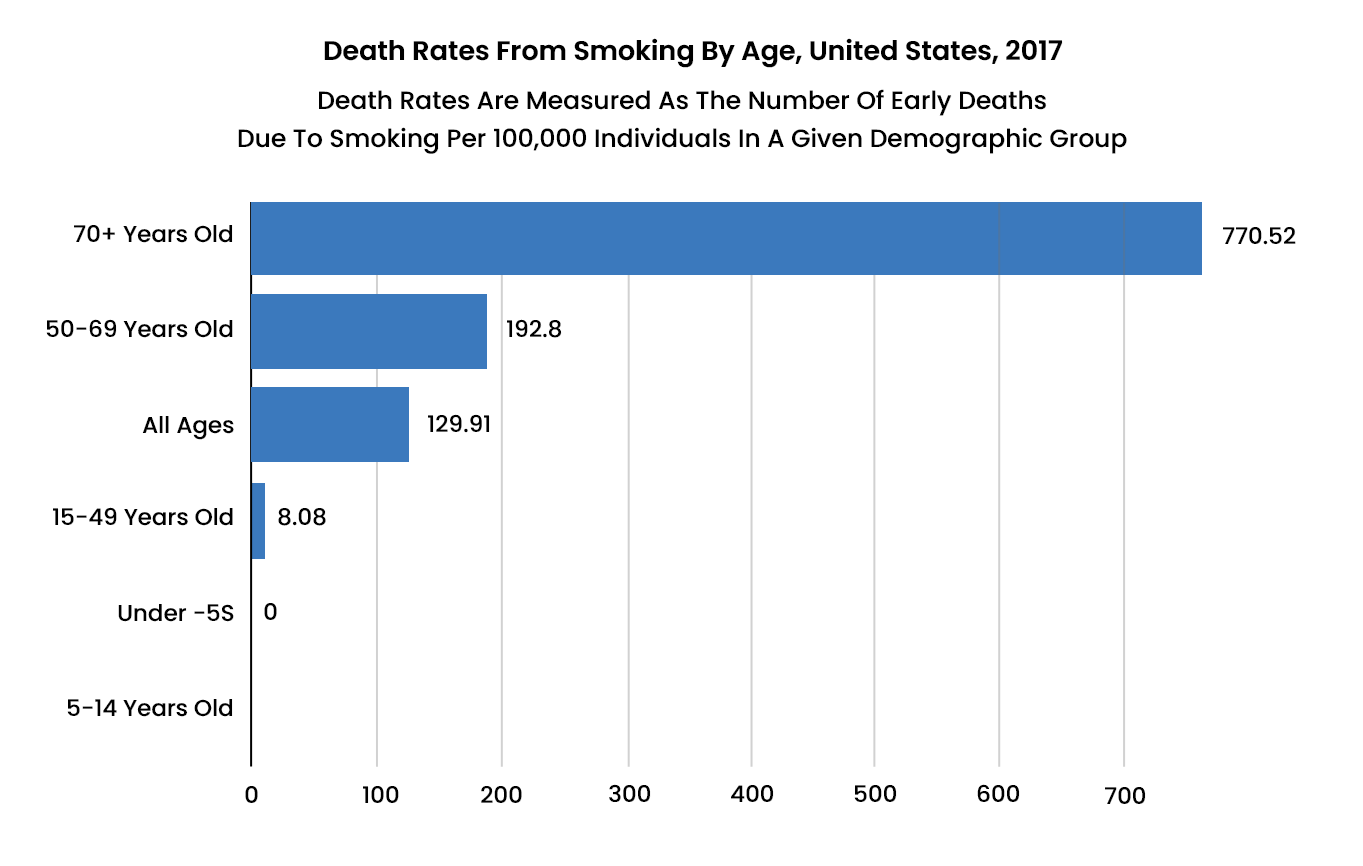
Smoking Cessation Statistics
As prolonged tobacco use results in the formation of dependence and other adverse health complications, many smokers quit or try to quit smoking each year to reduce the likelihood of developing smoking-related diseases. According to the Centers for Disease Control and Prevention (CDC), there have been more former smokers than current smokers in the US since 2002. The decrease in tobacco smoking in recent years is attributed to the aggressive and effective campaign against smoking, which helped educate Americans of the risks and consequences involved.
- About 68 percent of adult smokers admitted that they wanted to quit smoking in 2015.
- In 2018, around 55.1 percent of adult smokers reportedly made an attempt to quit the previous year.
- Only about 7.5 percent of adult smokers were successful in quitting smoking in 2017.
- In 2014, nearly 57.2 percent of adult smokers who had consulted a health professional reported receiving advice to quit.
- In 2018, approximately 55 million American adults quit smoking.
- In 2019, about 57.8 percent of middle and high school students who admitted to smoking were genuinely contemplating quitting for good.
- The percentage of smokers over 18 years of age who successfully quit smoking has been significantly increasing from 1965 to 2020.
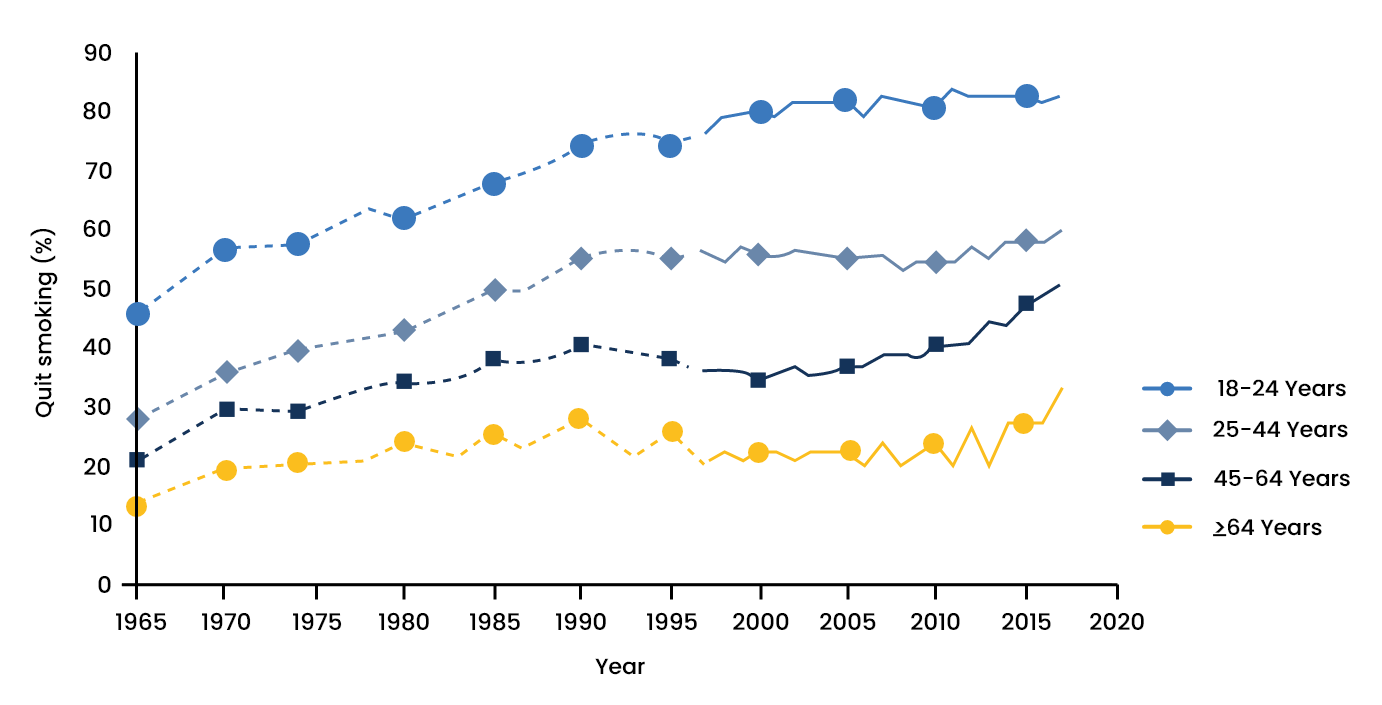
Economic Costs of Smoking Tobacco
Tobacco use imposes enormous costs on smokers as well as non-smokers, employers, and the general society in terms of healthcare, productivity loss, and premature deaths.
- The total economic cost of smoking is about $300 billion each year in the US.
- The US spends about $170 billion on medical care each year to treat smoking-related diseases in adults.
- Tobacco smoking cost the US more than $156 billion in lost productivity due to premature deaths each year
- The healthcare expenditure for secondhand smoke exposure is about $6 billion each year.
- The total economic cost of tobacco smoking was about $326 billion in 2014.
- According to recent health and medical spending surveys, about 8.7 percent of all healthcare spending is allotted to treat illnesses caused by regular smoking.
- According to the American Journal of Preventive Medicine, more than 60 percent of the $170 billion spent on smoking-related healthcare is funded by government sources.
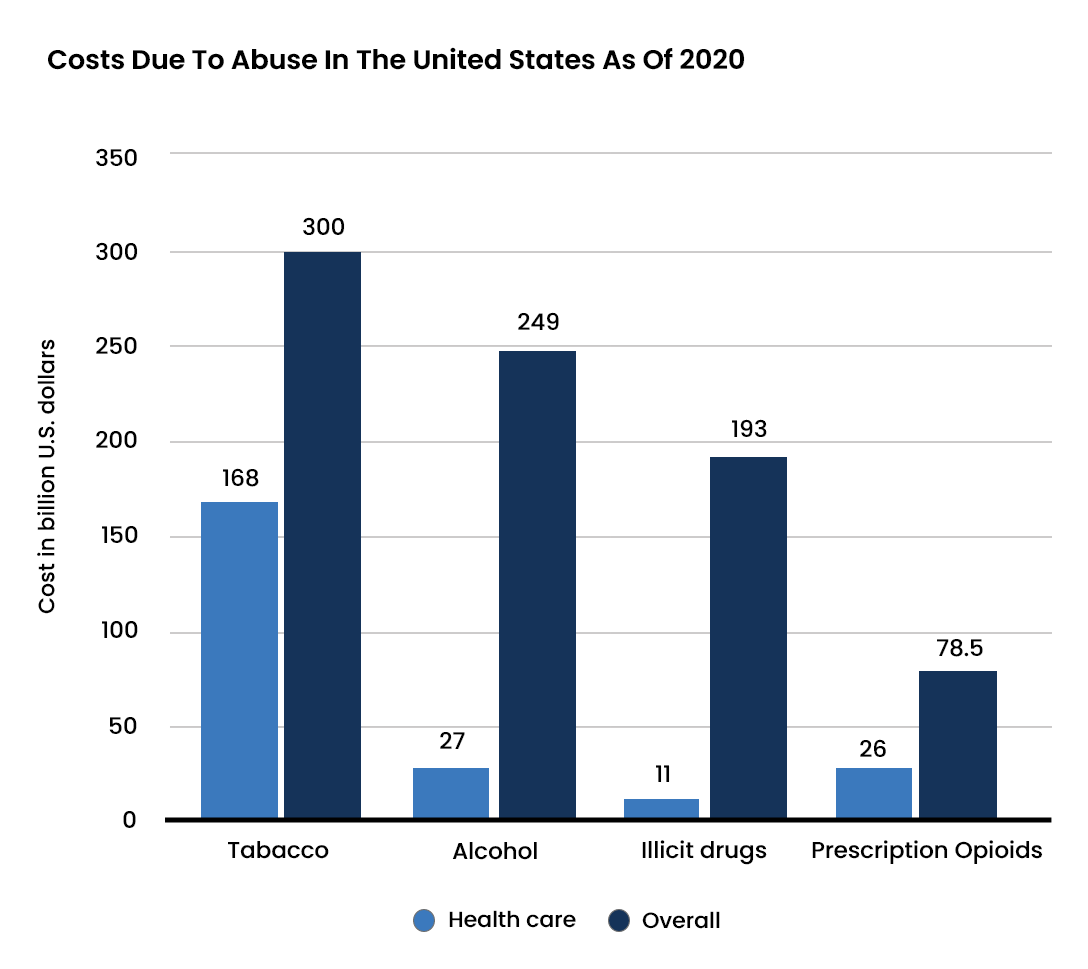
Recovery Partner Network
We aim to educate and empower. If you feel our library of resources does not cover your specific need, reach out to us, and we would be happy to help.
STATISTICS
© Copyright 2025

